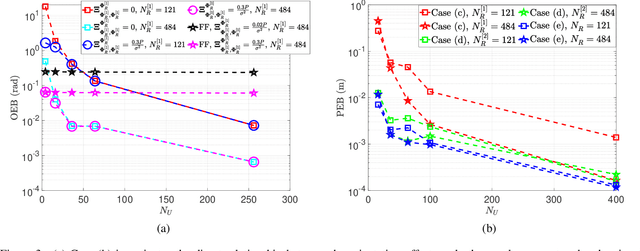RIS-Aided Localization under Position and Orientation Offsets in the Near and Far Field
Paper and Code
Oct 07, 2022



This paper presents a rigorous Bayesian analysis of the information in the signal (consisting of both the line-of-sight (LOS) path and reflections from multiple RISs) that originate from a single base station (BS) and is received by a user equipment (UE). For a comprehensive Bayesian analysis, both near and far field regimes are considered. The Bayesian analysis views both the location of the RISs and previous information about the UE as {\em a priori} information for UE localization. With outdated {\em a priori} information, the position and orientation offsets of the RISs become parameters that need to be estimated and fed back to the BS for correction. We first show that when the RIS elements have a half wavelength spacing, this RIS orientation offset is a factor in the pathloss of the RIS paths. Subsequently, we show through the Bayesian equivalent FIM (EFIM) for the channel parameters that the RIS orientation offset cannot be corrected when there is an unknown phase offset in the received signal in the far-field regime. However, the corresponding EFIM for the channel parameters in the received signal observed in the near-field shows that this unknown phase offset does not hinder the estimation of the RIS orientation offset when the UE has more than one receive antenna. Furthermore, we use the EFIM for the UE location parameters to present bounds for UE localization in the presence of RIS uncertainty. We rigorously show that regardless of size and propagation regime, the RISs are only helpful for localization when there is {\em a priori} information about the location of the RISs. Finally, through numerical analysis of the EFIM and its smallest eigenvalue, we demonstrate the loss in information when the far-field model is {\em incorrectly} applied to the signals received at a UE experiencing near-field propagation.
 Add to Chrome
Add to Chrome Add to Firefox
Add to Firefox Add to Edge
Add to Edge